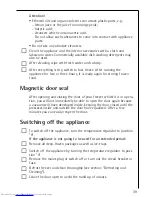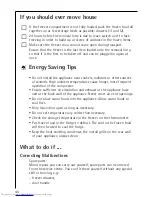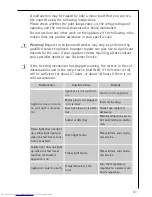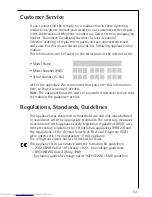
38
Each temperature rise reduces the keeping qualities of your frozen
food. Around 12 hours before defrosting your freezer, switch over to
fast freeze to built up a low temperature reserve in the frozen food.
Warning!
• Do not use electrical heating appliances or any other mechanical or
artificial devices to speed up the defrosting process.
• Do not use defrosting sprays, they can be hazardous to your health
and/or contain substances that damage plastics.
Caution!
Do not touch frozen food with wet hands. Your hands could
freeze to the food.
Remove frozen food, wrap it in several layers of newspaper and store it,
covered, in a cool place.
Switch off the appliance and unplug
it, or pull the fuse or switch off the
circuit breaker.
Remove all drawers except the bot-
tom one. The bottom drawer serves
as a practical container to collect the
water from the thawing ice. Pull out
the drawer and insert the plastic
scraper in the special location to act
as an extension channel to collect
the defrost water.
Tip:
To speed up the defrosting pro-
cess, place a pan with hot water in the appliance and close the door.
Remove pieces of ice that have fallen before they completely defrost.
After defrosting, thoroughly clean the freezer compartment and interi-
or fittings.
Warning!
• The appliance may not be connected to the mains during cleaning.
Danger of electrical shock! Before cleaning switch the appliance off
and remove the plug from the mains, or switch off or turn out the
circuit breaker or fuse.
• Never clean the appliance with a steam cleaner. Moisture could accu
mulate in electrical components, danger of electrical shock! Hot
vapours can lead to the damage of plastic parts.
• The appliance must be dry before it is placed back into service.
☞
☞
☞
☞
☞







































